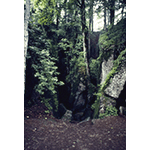Museo del Santuario de La Verna [Sanctuary of La Verna Museum]
After a long period of closure due to a number of thefts, on December 7, 2002 the new La Verna Museum was inaugurated. It bears witness to the art, history and monastic life in the Sanctuary, in an itinerary that unfolds through a number of rooms up terminating in that of the "common hearth", in which the community met each evening.
The museum's itinerary includes the Ancient Pharmacy, instituted in 1549 at the expense of Cosimo de' Medici and his wife Eleonora di Toledo, now restored in a room situated inside the Sanctuary. Already in the 17th century the products of the pharmacy were famous, so much so that the monastery's pharmacists spent a period of training there before going on the pharmacy in Florence, situated in the monastery of Ognissanti. After a slow decline, the pharmacy was closed 1866 subsequent to the law sanctioning closure of the monasteries.
Today the furnishings and pharmaceutical equipment that document its ancient history include: walnut shelves with doors and vitrines, slender columns and decorations in the style of the first half of the 19th century, majolica jars bearing the monastery's coat of arms with a cross supported by three mountains, albarellos and alembics for distilling made of antique pharmaceutical glass. On the same floor as the pharmacy, in the cloistered area, is a rare example of a column clock from the 18th century, actuated by weights, signed Francesco Nuzzi di Rincine. Restored a few years ago by the Arezzo clockmaker Francesco Burzi, it is still functioning.
The Museum possesses a number of scientific instruments, including two antique quadrants, three hourglasses and a perpetual calendar. It also has two herbariums: the Herbarium Semplici in natura [Medicinal herbs in nature] collected by Francesco Maria Venturini in 1711 and the Herbier by A. Philouse from 1950.
****************************
Texts by Mara Miniati
English translation by Catherine Frost
Last update 13/feb/2008




